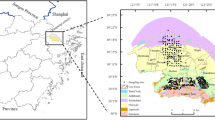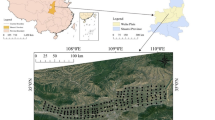Abstract
Purpose
Rapid and accurate estimation of soil organic carbon (SOC) based on near-infrared spectroscopy can assist sustainable agricultural developments in the future.
Methods
In this study, based on the acquisition of soil spectra and SOC in field plot trials and farmland regional trials, the raw spectral data were processed by multi-class mathematical transformation to study the relationship between the raw spectra and their pre-processed spectra and SOC. Additionally, a near-infrared spectroscopy model has been constructed for the estimation of SOC based on multiple statistical regression (partial least squares, PLS; Support vector machine, SVM; successive projection algorithm-multiple linear regression, SPA-MLR) to resolve the optimal spectral pretreatment and modeling method suitable for SOC determination by Vis–NIR spectroscopy.
Results
The results revealed that the soil NIR spectra were negatively correlated with SOC, which suggested that the spectral reflectance decreased gradually with the increasing SOC content. A comparative analysis of the correlation between the original and pre-treatment spectra and SOC further revealed that except for the Savitzky-Golay smoothing treatment (T1), different spectral pretreatments significantly improved the correlation between soil spectra and SOC, and the maximum correlation coefficient could reach up to 0.8. Among the three types of multiple regression models based on different pretreatment conditions, the support vector machine and model of soil organic carbon based on Savitzky-Golay smoothing + first derivative (T7) achieved better estimation results (R2c = 0.9212, RMSEc = 1.4058, RPDc = 4.3403; R2v = 0.7556, RMSEv = 2.4589, RPDv = 2.0186).
Conclusions
Our findings provided some theoretical reference and practical application of the near-infrared spectroscopy-based estimation of organic carbon in agricultural soils.






Similar content being viewed by others
References
Ahmad S, Kalra A, Stephen H (2010) Estimating soil moisture using remote sensing data: a machine learning approach. Adv Water Resour 33(1):69–80. https://doi.org/10.1016/j.advwatres.2009.10.008
Allo M, Todoroff P, Jameux M et al (2020) Prediction of tropical volcanic soil organic carbon stocks by visible-near-and mid-infrared spectroscopy. CATENA 189. https://doi.org/10.1016/j.catena.2020.104452
Angelopoulou T, Balafoutis A, Zalidis G et al (2020) From laboratory to proximal sensing spectroscopy for soil organic carbon estimation—a review. Sustainability 12(2):443. https://doi.org/10.3390/su12020443
Bangelesa F, Adam E, Knight J et al (2020) Predicting soil organic carbon content using hyperspectral remote sensing in a degraded mountain landscape in lesotho. Appl Environ Soil Sci. https://doi.org/10.1155/2020/2158573
Cécillon L, Barthès BG, Gomez C et al (2009) Assessment and monitoring of soil quality using near-infrared reflectance spectroscopy (NIRS). Eur J Soil Sci 60(5):770–784. https://doi.org/10.1111/j.1365-2389.2009.01178.x
Chakraborty S, Weindorf DC, Li B et al (2014) Analysis of petroleum contaminated soils by spectral modeling and pure response profile recovery of n-hexane. Environ Pollut 190:10–18. https://doi.org/10.1016/j.envpol.2014.03.005
Cozzolino D, Morón A (2006) Potential of near-infrared reflectance spectroscopy and chemometrics to predict soil organic carbon fractions. Soil Tillage Res 85(1–2):78–85. https://doi.org/10.1016/j.still.2004.12.006
Davari M, Karimi SA, Bahrami HA et al (2021) Simultaneous prediction of several soil properties related to engineering uses based on laboratory Vis-NIR reflectance spectroscopy. CATENA 197. https://doi.org/10.1016/j.catena.2020.104987
Dotto AC, Dalmolin RSD, Grunwald S et al (2017) Two preprocessing techniques to reduce model covariables in soil property predictions by Vis-NIR spectroscopy. Soil Tillage Res 172:59–68. https://doi.org/10.1016/j.still.2017.05.008
Dotto AC, Dalmolin RSD, Ten Caten A et al (2018) A systematic study on the application of scatter-corrective and spectral-derivative preprocessing for multivariate prediction of soil organic carbon by Vis-NIR spectra. Geoderma 314:262–274. https://doi.org/10.1016/j.geoderma.2017.11.006
Gholizadeh A, Borůvka L, Saberioon MM et al (2015) Comparing different data preprocessing methods for monitoring soil heavy metals based on soil spectral features. Soil and Water Res 10(4):218–227. https://doi.org/10.17221/113/2015-SWR
Guo L, Zhang H, Shi T et al (2019) Prediction of soil organic carbon stock by laboratory spectral data and airborne hyperspectral images. Geoderma 337:32–41. https://doi.org/10.1016/j.geoderma.2018.09.003
Hong Y, Chen S, Zhang Y et al (2018) Rapid identification of soil organic matter level via visible and near-infrared spectroscopy: effects of two-dimensional correlation coefficient and extreme learning machine. Sci Total Environ 644:1232–1243. https://doi.org/10.1016/j.scitotenv.2018.06.319
Jia X, Chen S, Yang Y et al (2017) Organic carbon prediction in soil cores using VNIR and MIR techniques in an alpine landscape. Sci Rep 7(1):1–9. https://doi.org/10.1038/s41598-017-02061-z
Lei T, Lin XH, Sun DW (2019) Rapid classification of commercial Cheddar cheeses from different brands using PLSDA, LDA and SPA–LDA models built by hyperspectral data. J Food Meas Charact 13(4):3119–3129. https://doi.org/10.1007/s11694-019-00234-0
Lucà F, Conforti M, Castrignanò A et al (2017) Effect of calibration set size on prediction at local scale of soil carbon by Vis-NIR spectroscopy. Geoderma 288:175–183. https://doi.org/10.1016/j.geoderma.2016.11.015
Morra MJ, Hall MH, Freeborn LL (1991) Carbon and nitrogen analysis of soil fractions using near-infrared reflectance spectroscopy. Soil Sci Soc Am J 55(1):288–291. https://doi.org/10.2136/sssaj1991.03615995005500010051x
Moura Bueno JM, Dalmolin RSD, Ten Caten A et al (2019) Stratification of a local VIS-NIR-SWIR spectral library by homogeneity criteria yields more accurate soil organic carbon predictions. Geoderma 337:565–581. https://doi.org/10.1016/j.geoderma.2018.10.015
Nawar S, Mouazen AM (2019) On-line vis-NIR spectroscopy prediction of soil organic carbon using machine learning. Soil Tillage Res 190:120–127. https://doi.org/10.1016/j.still.2019.03.006
Nawar S, Mouazen AM (2017) Predictive performance of mobile vis-near infrared spectroscopy for key soil properties at different geographical scales by using spiking and data mining techniques. CATENA 151:118–129. https://doi.org/10.1016/j.catena.2016.12.014
Ramirez-Lopez L, Behrens T, Schmidt K et al (2013) The spectrum-based learner: a new local approach for modeling soil vis–NIR spectra of complex datasets. Geoderma 195:268–279. https://doi.org/10.1016/j.geoderma.2012.12.014
Rinnan Å, Van Den Berg F, Engelsen SB (2009) Review of the most common pre-processing techniques for near-infrared spectra. TrAC Trends Anal Chem 28(10):1201–1222. https://doi.org/10.1016/j.trac.2009.07.007
Seema, Thakur A (2019) NIR analysis as an integrated tool for the assessment of soil quality. J Pharmacogn Phytother 8(1):1985–1987. https://www.phytojournal.com/archives/2019/vol8issue1/PartAG/8-1-447-241.pdf
Seema, Ghosh AK, Das BS et al (2020) Application of VIS-NIR spectroscopy for estimation of soil organic carbon using different spectral preprocessing techniques and multivariate methods in the middle Indo-Gangetic plains of India. Geoderma Reg 23: e00349. https://doi.org/10.1016/j.geodrs.2020.e00349
Sharififar A, Singh K, Jones E et al (2019) Evaluating a low-cost portable NIR spectrometer for the prediction of soil organic and total carbon using different calibration models. Soil Use Manag 35(4):607–616. https://doi.org/10.1111/sum.12537
Shen L, Gao M, Yan J et al (2020) Hyperspectral estimation of soil organic matter content using different spectral preprocessing techniques and PLSR method. Remote Sens 12(7):1206. https://doi.org/10.3390/rs12071206
Srivastava R, Sarkar D, Mukhopadhayay SS et al (2015) Development of hyperspectral model for rapid monitoring of soil organic carbon under precision farming in the Indo-Gangetic Plains of Punjab, India. J Indian Soc Remote Sens 43(4):751–759. https://doi.org/10.1007/s12524-015-0458-0
Sun W, Li X, Niu B (2018) Prediction of soil organic carbon in a coal mining area by Vis-NIR spectroscopy. PLoS ONE 13(4). https://doi.org/10.1371/journal.pone.0196198
Sun XL (2021) Errors induced by spectral measurement positions and instrument noise in soil organic carbon prediction using vis-NIR on intact soil. Geoderma 382. https://doi.org/10.1016/j.geoderma.2020.114731
Vašát R, Kodešová R, Klement A et al (2017) Simple but efficient signal pre-processing in soil organic carbon spectroscopic estimation. Geoderma 298:46–53. https://doi.org/10.1016/j.geoderma.2017.03.012
Viscarra Rossel RA, Behrens T (2009) Using data mining to model and interpret soil diffuse reflectance spectra. Geoderma 158(1–2):46–54. https://doi.org/10.1016/j.geoderma.2009.12.025
Vohland M, Emmerling C (2011) Determination of total soil organic C and hot water-extractable C from VIS-NIR soil reflectance with partial least squares regression and spectral feature selection techniques. Eur J Soil Sci 62(4):598–606. https://doi.org/10.1111/j.1365-2389.2011.01369.x
Wahl J, Sjödahl M, Ramser K (2020) Single-step preprocessing of Raman spectra using convolutional neural networks. Appl Spectrosc 74(4):427–438. https://doi.org/10.1177/0003702819888949
Wu D, Wang SJ, Wang NF et al (2013) Application of time series hyperspectral imaging (TS-HSI) for determining water distribution within beef and spectral kinetic analysis during dehydration. Food Bioproc Tech 6(11). https://doi.org/10.1007/s11947-012-0928-0
Xu L, Hong Y, Wei Y et al (2020) Estimation of organic carbon in anthropogenic soil by VIS-NIR Spectroscopy: effect of variable selection. Remote Sens 12(20):3394. https://doi.org/10.3390/rs12203394
Xu S, Wang M, Shi X (2020) Hyperspectral imaging for high-resolution mapping of soil carbon fractions in intact paddy soil profiles with multivariate techniques and variable selection. Geoderma 370. https://doi.org/10.1016/j.geoderma.2020.114358
Zhang Z, Ding J, Zhu C et al (2021) Strategies for the efficient estimation of soil organic matter in salt-affected soils through Vis-NIR spectroscopy: optimal band combination algorithm and spectral degradation. Geoderma 382. https://doi.org/10.1016/j.geoderma.2020.114729
Zhu C, Zhang Z, Wang H et al (2020) Assessing soil organic matter content in a coal mining area through spectral variables of different numbers of dimensions. Sensors 20(6):1795. https://doi.org/10.3390/s20061795
Funding
This work was funded by the National Natural Science Foundation of China (31871571, 31371572), the Outstanding Doctor Funding Award of Shanxi Province (SXYBKY2018040), the earmarked fund for Modern Agro-industry Technology Research System (2022-07) and the Higher education Project of Scientific and Technological Innovation in Shanxi (2020L0132). The project was also supported by the Scientific and Technological Innovation Fund of Shanxi Agricultural University (2018YJ17, 2020BQ32) and the Key Technologies R & D Program of Shanxi Province (201903D211002).
Author information
Authors and Affiliations
Corresponding authors
Ethics declarations
Competing interests
The authors declare no competing interests.
Additional information
Responsible editor: Xiuping Jia
Publisher's Note
Springer Nature remains neutral with regard to jurisdictional claims in published maps and institutional affiliations.
Rights and permissions
Springer Nature or its licensor holds exclusive rights to this article under a publishing agreement with the author(s) or other rightsholder(s); author self-archiving of the accepted manuscript version of this article is solely governed by the terms of such publishing agreement and applicable law.
About this article
Cite this article
Wang, Y., Yang, S., Yan, X. et al. Evaluation of data pre-processing and regression models for precise estimation of soil organic carbon using Vis–NIR spectroscopy. J Soils Sediments 23, 634–645 (2023). https://doi.org/10.1007/s11368-022-03337-2
Received:
Accepted:
Published:
Issue Date:
DOI: https://doi.org/10.1007/s11368-022-03337-2




